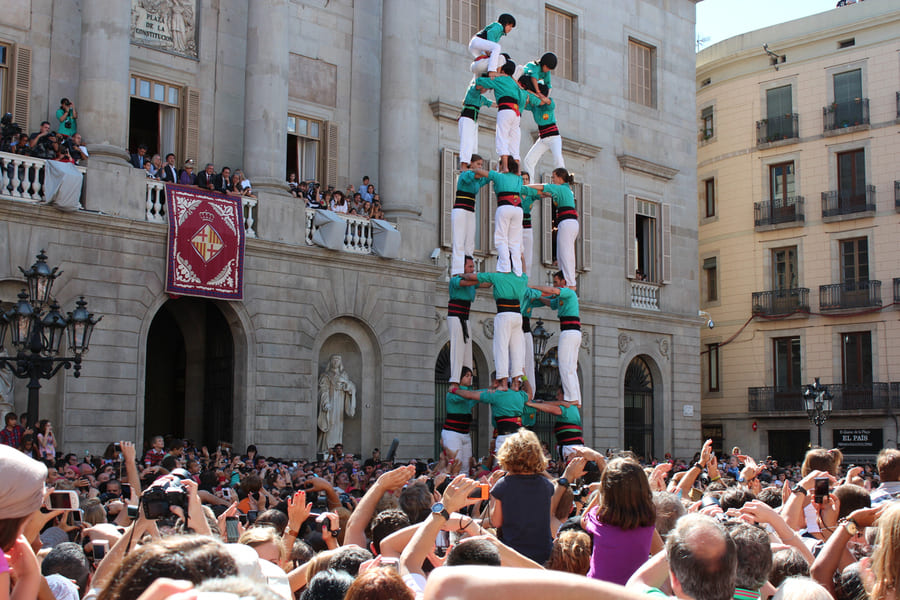Catalonia is an autonomous community in northeastern Spain, with its own distinct language and identity.
One of the most prominent aspects of Catalan culture is its language, Catalan. It is spoken by the majority of the population in Catalonia and has official status in the region. Catalan literature has a long and esteemed history, with celebrated authors such as Joan Maragall, Salvador Espriu, and Josep Pla.

Catalonia is also known for its vibrant art scene, with renowned artists like Joan Miró and Antoni Tàpies hailing from the region. The Catalan capital of Barcelona is home to several world-class museums, including the Museu Picasso and the Museu Nacional d’Art de Catalunya, which showcase the rich artistic heritage of Catalonia.
Catalan cuisine is another important aspect of the region’s culture. Traditional Catalan dishes often feature Mediterranean ingredients, such as fish, vegetables, and olive oil.
Catalonia has a long history, and its culture reflects influences from various periods and civilizations. The region has been inhabited since ancient times, and this is evident in its archaeological sites, such as the Roman ruins of Tarragona.
Catalan culture also has a strong tradition of arts and literature. Many famous artists, such as Antoni Gaudí and Joan Miró, were born in Catalonia and left their.
The Barcelonans
Life in Barcelona is characterized by dynamic commercial activity and a vibrant social scene – seasoned with a dash of cosmopolitanism thanks to the many outsiders who come here to work and play.
Market trading
Like England, Catalonia has been dubbed a nation of shopkeepers, and indeed, Barcelona has a staggering number of shops. This is not so surprising when you consider its mercantile background, going back to the Phoenicians.
This bourgeois city was built up through family enterprise, and has now become one of the places to shop. The slogan once sported by carrier bags of the famous Vingon design store puts it in a nutshell: “I shop, therefore I am.” Barcelona exudes an air of prosperity, and is no longer a particularly cheap city. The standard of living is high, but it has to be paid for, and the work ethic is especially noticeable if you come here from elsewhere in Spain. You can see it in the comparatively early closing (by Spanish standards) of bars and restaurants.
Efficiency, punctuality and reliability are of the essence. Barcelona works very hard.
Prudence versus impulse
The Catalans call these apparently contradictory facets of their character el seny and la rauxa. The former is a combination of prudence, profound common sense and sensible judgement, the latter a fit, impulse or emotional outburst: a kind of attack of wildness.
You can see both sides of the Catalan character in the way they drive. Unlike in other flamboyant cities, the traffic in Barcelona is orderly.
Drivers stop on red, and go on green. But if you hesitate a split second, or worse still, stall, you’ll be deafened by furious honking. When traffic gets really snarled up, rauxa takes over. Patience is no longer a virtue: you must get going, be on the mark, have your wits about you.
Barcelonans may work until they’re blue in the face, but they’re still Mediterranean people: creative, fun-loving, noisy and gregarious.
As Barcelona’s celebrated Olympic Games of 1992 set out to show the world, Mediteranean high spirits.
A clash of cultures
Barcelonans work hard all week, then sit in traffic jams every Friday afternoon so they can Enjoy weekends by the sea or in the mountains.
They have little time for the wish-washy: theirs are the strong, bright primary colours of Miró. They are adventurous travellers, visiting the most remote corners of the world. They value initiative and pioneering enterprise.
Barcelona is intensely involved internationally in science, education, ecology and other fields.
But they do come over as reserved and serious beside the many citizens originally from other parts of Spain, the migrants who flooded in during the 1950s and 1960s in search of work. Coexistence has sometimes been a thorny matter, with ethnic, class and cultural differences all intertwined: the Catalan middle classes often take a dim view of the ebullient non Catalan working class, and vice versa.
Street life
Like all good Mediterraneans, Barcelonans are a street people. All it takes is a few tables squeezed onto a postage stamp of pavement, and they’ll sit for hours over their drinks and olives, apparently oblivious to the fumes and traffic noise.
When it rains, the milling throngs leap into cars and taxis, causing the traffic to “collapse”, as they put it, in a cacophony of blasting horns.
One of the highest accolades a Barcelonan can receive is that he or she is espavilat or espavilada, which can be translated as awake or alert. This proactive zooming around encompasses not only work, but a host of other activ-ittes – from culture, shopping and social life to voluntary work, chauffering children, sports… you name it.
FOOTBALL
Barcelona Football Club – Barca – was founded in 1899 by Hans Gamper, a Swiss living in Barcelona. One of its slogans is that it is “més que un club” more than a club – but one of its special features is that it really is a club: its 105.000 + paid up fans are members who vote for the board, not “season-ticket holders”. This huge fan base comes from the whole of Catalonia, not just the city. Barça is a symbol of Catalonia, even when its stars are from Brazil, Argentina or Cameroon.
The club gained its curious political role as a champion of Catalan freedom during times when Catalan identity was blocked everywhere else, under Primo do Rivera in the 1920s and, far more intensely, under Franco. Stadium crowds are hard to censor, and the blue-and-maroon (blaugrana) flag of Barça became a substitute for the Catalan colours. Catalan emotions came to a head in meetings with Real Madrid, a symbol of the regime and right-wing Spain.
After the return of democracy this kind of football politics did seem to fade for a while, and it even seemed possible that football could just be a game, but it has revived with vigour, and taken on new forms. Plus, Barcelona has one of the best teams in the world.
Sardanas
Sardanas is a traditional Catalan circle dance that originated in the region of Catalonia, in northeastern Spain. It is a lively and joyful dance that is usually performed outdoors, in squares or parks, by participants holding hands together in a large circle.
The origins of the sardanas can be traced back to the late 19th century when it was inspired by ancient dance forms. The dance has since become an integral part of Catalan culture and is often performed during festivals, celebrations, and national holidays.

The music accompanying the sardanas is typically played by a cobla, which is a traditional Catalan musical ensemble. The cobla consists of various traditional instruments such as the flabiol (a recorder-like instrument), the tible (a double-reed instrument), the tenora (a double-reed instrument similar to an oboe), and the fiscorn (a brass instrument similar to a tuba).
Human towers “castells”
Human towers, known as “castells,” have a long-standing tradition in Catalonia, Spain. These impressive structures are created by teams of participants who intricately balance on top of each other to form towering formations.
The construction of castells typically involves different levels of individuals forming a strong base, known as the “pinya,” on which the tower is built. This base provides a solid foundation for the tower to reach impressive heights. The participants then climb on top of each other, with each level becoming progressively smaller and more fragile.

Skilled climbers, known as “castellers,” ascend the tower and take their positions on the upper levels, forming intricate and beautiful patterns. The highest participant, known as the “enxaneta,” is a young child who stands on top of the tower, symbolizing the culmination of the collective effort.
The construction of human towers requires coordination, physical strength, balance, and trust among the participants.
Saint george
The story of Saint George and the Dragon is a legendary tale that has been passed down through the generations. It is a popular story in many different cultures and is often associated with the Christian faith.
According to the legend, Saint George was a Roman soldier who lived during the 3rd century. He is said to have been a brave and courageous man who was known for his strong faith in Christianity.

The story goes that George arrived in a city that was being terrorized by a ferocious dragon. This dragon had the ability to breathe fire and was causing great destruction. In order to appease the dragon, the people of the city had been sacrificing a sheep to it each day. However, when the sheep ran out, they started sacrificing children instead.
News of this reached Saint George, and he was deeply troubled by the suffering of the people. He decided to confront the dragon and save the people from its terror.
It turns out that in the blood of the dragon began to grow red roses, which on April 23 every year they give red roses and on the other hand books, for the anniversary of Cervantes and Shakespeare.
So the Casa Batlló, it’s another building of Gaudi who is inspired of the history of Sant Gorge, according to the legend sant gorge save a princes from a dragon who wants to eat her, he killed the dragon then when he died red roses grow up from his blood.
The culture of Catalonia is rich and diverse, with influences from various historical and artistic movements.






